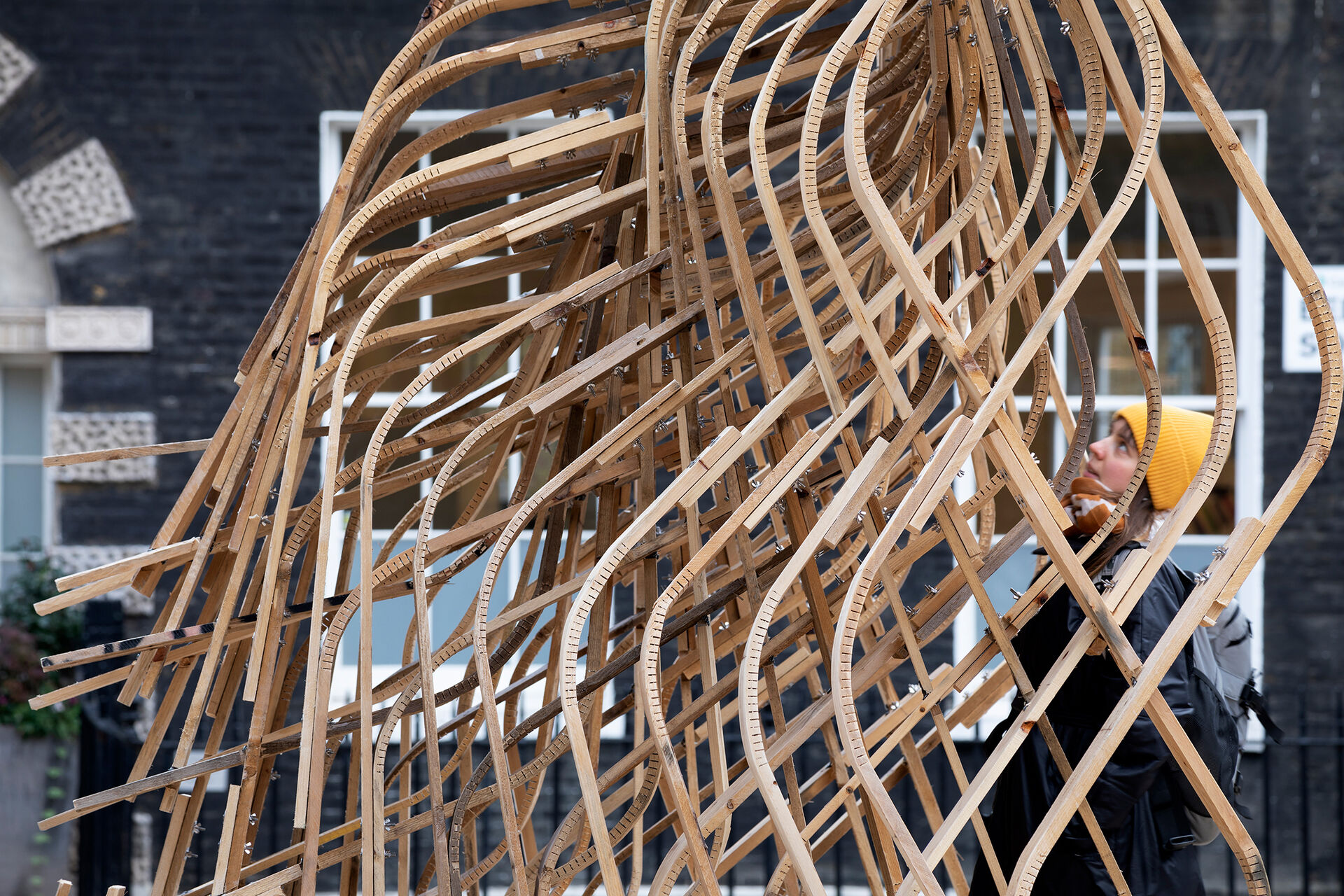Re-Emerge Pavilion - a collaboration between AA [EmTech] and Hassell

We have collaborated with the Architectural Association (AA) Emergent Technologies & Design (EmTech) Post-Graduate Programme to create a new pavilion in Bedford Square, London.
EmTech Post-Graduate Programme at the Architectural Association has a long history in designing and creating structures and pavilions. This year’s pavilion is titled Re-Emerge and is the first time since the pandemic that the students could closely work together, fabricate and assemble a full-scale structure.
For this collaboration, Hassell gave the students the challenge to keep the carbon footprint of the project to an absolute minimum and therefore only use reclaimed timber.
Head of Design, Xavier de Kestlier said: “The students really took on the challenge with both hands and decided early on to build the pavilion out of timber from reclaimed wooden pallets”
The Re-Emerge pavilion explores new design and construction technologies that repurpose materials which have completed their first life cycle towards innovative structural formations. The project addresses themes of generative design, material computation, large-scale fabrication and assembly technologies, emphasising the pavilion’s ecological impact from the early phases of the design process onwards.
Re-emerge revives the tradition of building on Bedford Square as a collaboration between an academic programme at the AA and partners from the world of practice, to test ideas at scale and imagine new possibilities.
Director of the EmTech Program, Dr. Elif Erdine said: “This collaboration with Hassell demonstrates a successful illustration of how academia and practice can come together to discover novel solutions to complex spatial and material problems. With the support of our other sponsors, BuroHappold Engineering and One Click LCA, EmTech and Hassell explored new design and construction technologies for repurposing timber.”
She added: “As designers, architects, and engineers, we share the responsibility to maintain a mindful approach towards our environment while designing and building. Our mutual insight into how construction waste can be a useful resource has originated this research into repurposing timber for an outdoor structure that is lightweight, emphasising the project’s ecological impact from the early phases of the design process.”
Construction waste is useful.
Wood is inherently the best bio-fabricated and biodegradable material; it is renewable, resilient, and last for a long time. When a timber building is demolished after several decades, it does not produce useless waste, but instead generates reclaimed wood that can be re-used and re-purposed in other applications after disassembly, hence becoming part of the circular economy.
Re-Emerge is created with grade A reclaimed wood pallets, one of the most abundant re-used timber elements in the AEC industry. Reclaimed timber pallets generally end up in landfill or burnt as fuel. Instead, their structural and morphological capacities are explored and exploited in Re-Emerge. Reclaimed pallets have been collected from various timber recycling facilities in and outside London.
Xavier De Kestelier says: “For the last couple of decades architects have often focussed on performance of buildings and minimising operational carbon in buildings. But with the need to tackle climate change more urgently we also need to look at embodied carbon. Re-Emerge was a great way for the students to start embedding this approach in their design. “
Structure
The structural system for Re-Emerge is comprised of volumetric timber diamond shaped modules that are created by scoring and kerfing wood pallets. The diamond modules are organised into structural ribs, which are then assembled with lap joints; thereby diminishing the need for secondary materials in the joinery system. The system can sustain loads in vertical and horizontal arrangements
Complexity arises from simplicity.
“In this project we aimed to explore how complexity can arise from simplicity. This was adopted by the variable aggregation of similar modules that are formed by scoring and steam-bending. A further ambition of the project was to diminish the need for secondary materials in the joinery system, and this decision has led us to work with lap joinery throughout the structure,” explains Elif Erdine.
The conscious attitude of the project towards the environment is maintained in its fabrication and instalment.
Life Cycle Assessment (LCA) of the reclaimed timber planks employed for the construction highlights insightful information for the preliminary design phase. Analysis of most plywood types used for external construction versus solid timber planks demonstrates that CO2 emissions of plywood is significantly higher than solid planks during the preparation stage
Studio Master at EmTech, Dr. Milad Showkatbakhsh explains: “The employment of life cycle assessment (LCA) in our computational workflows as a design driver has enabled us to take into consideration CO2 emissions associated with not only the material itself, but also its origins and transportation to site.”
Studio Tutor at EmTech, Eleana Polychronaki explains: “There is also a dedicated app for the visitors of the pavilion. The Augmented Reality app allows users to find out about the Life Cycle Assessment of the pavilion, information on its design and fabrication processes, as well as various visualisation options, including a scaled AR projection of the pavilion. The app also shows the story of the reclaimed timber that is used for construction, where it came from, and what its first life cycle was”
Third Life
At the end of its second lifecycle, Re-Emerge will be disassembled. Part of the pavilion will be erected in our London studio and part of it will be send back to the timber recycling facilities where it was resourced from. The ambition of Re-Emerge is to create a strong dialogue between the local timber industry and its by-products, and to demonstrate to the world that innovative timber architecture can be created with construction waste, while maintaining a mindful approach towards our environment.
The pavilion is open to the public on the corner of Bedford Square right opposite the Architectural Association until 25 November.